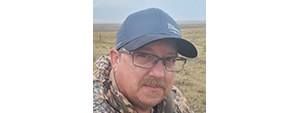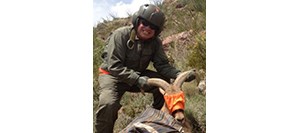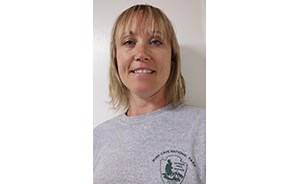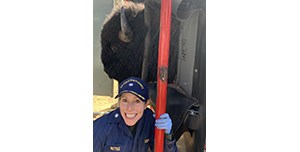Last updated: July 31, 2023
Article
A New Treatment to Control Plague in Wildlife Shows Promise
Experiments with fipronil-laden prairie dog bait suggest the insecticide can be a powerful tool for reducing the "Black Death" in wildlife, especially if integrated with other methods.
By David Eads, Scott Carleton, Travis Livieri, Eddie Childers, Phil Dobesh, John Hughes, Paul Roghair, Angela Jarding, and Danielle Buttke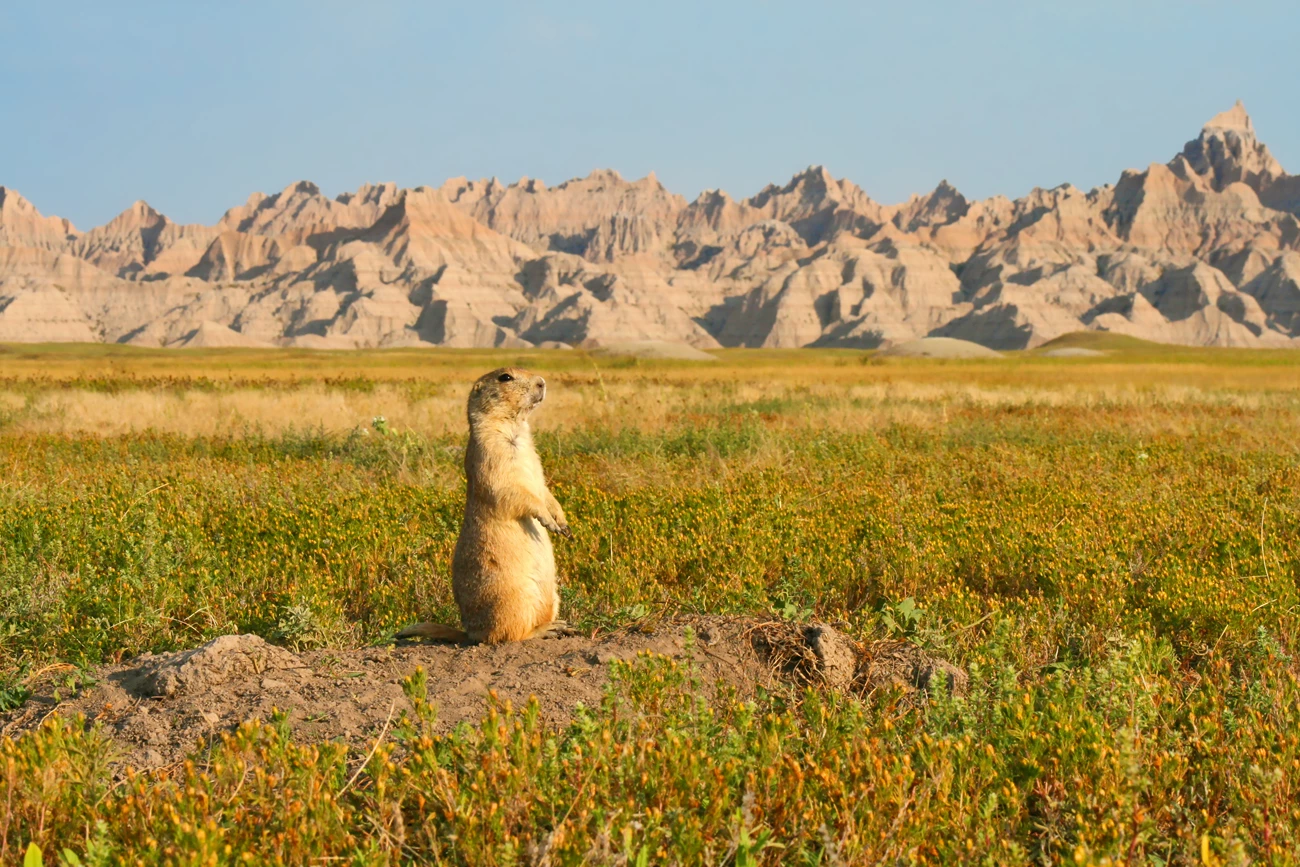
Image credit: U.S. Geological Survey / David Eads
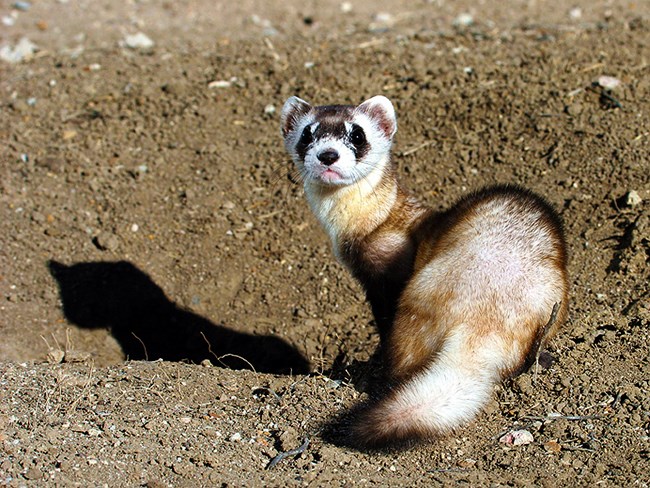
Image credit: U.S. Fish and Wildlife Service
Referred to as the “Black Death” during the devastating epidemic in 14th-century Europe, plague is an invasive, non-native disease in the Americas. Flea-carrying rats aboard Eurasian trading ships introduced it to the west coast of the United States in the early 1900s. Although no longer widespread in people, it is prevalent in the western U.S. It affects mammals in our national parks like black-tailed prairie dogs and their predators, endangered black-footed ferrets. Biologists manage plague by using insecticides like deltamethrin dust to kill the fleas that carry and pass it to the animals they bite. But fleas can develop resistance to one insecticide when it is used repeatedly. A more sustainable, cost-effective approach uses integrated methods to manage the disease with minimal adverse environmental, economic, or safety impacts.
A recent paper in the journal, PLoS One, describes laboratory trials and field experiments for controlling plague with fipronil-laden grain as bait for prairie dogs. Scientists from the U.S. Geological Survey and other institutions authored the paper. Study sites included Buffalo Gap National Grassland, Badlands National Park, and Lower Brule Indian Reservation, all in South Dakota. Used in rotation with or instead of insecticides like deltamethrin dust, the new treatment shows promise for plague control and safer wildlife conservation.
Vulnerable Populations
Black-tailed prairie dogs are extremely susceptible to plague. This is partly because they live in densely populated colonies, where the disease can quickly decimate their numbers. In the early 2000s, scientists thought plague was absent from Badlands National Park and surrounding areas in South Dakota, although they knew it to be present just to the west in Wyoming. In 2005, park biologists and collaborators tried to forestall an oncoming wave of plague in Badlands and Buffalo Gap National Grassland by using deltamethrin dust. It’s the most widely used tool for plague control in prairie dog colonies, reducing prairie dog fleas for up to 24 months. Applying deltamethrin dust is a proven technique against plague, though there are exceptions.
It killed prairie dogs from over 90 percent of more than 14,000 acres. These sites collectively contained over 300 black-footed ferrets, the largest population in the world.
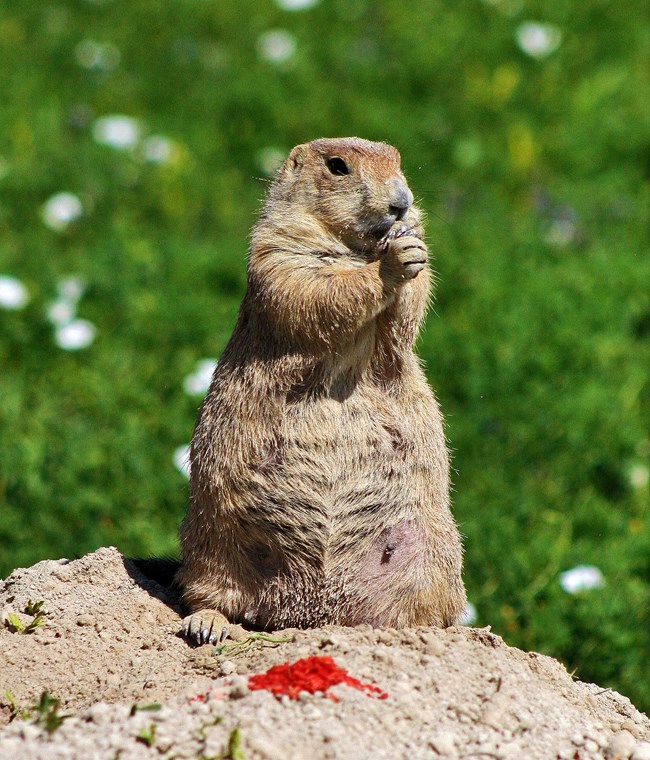
Image credit: U.S. Geological Survey / David Eads
But in 2008, despite the best efforts of site managers, plague invaded Badlands and Buffalo Gap, including the Conata Basin. It spread rapidly throughout the grassland ecosystem. It killed prairie dogs from over 90 percent of more than 14,000 acres of habitat not treated with deltamethrin dust. These sites collectively contained over 300 black-footed ferrets, the largest population in the world. The arrival of plague caused ferret numbers to decline to only 71 individuals. And by 2009, deltamethrin dust seemed to be losing its effectiveness at Badlands, possibly due to flea resistance to the insecticide. Scientists had seen this in other flea species repeatedly treated with one insecticide, so this setback did not come as a surprise.
A study concluded in 2015 found evidence of flea resistance to deltamethrin in prairie dog colonies treated with the chemical for 10 or more years. The study showed that one third of fleas from colonies with long-term exposure to deltamethrin survived. This result was a “game changer” in combating the impacts of plague on wildlife populations. It was obvious plague management needed a new and more effective method.
Following the results of their study, the researchers set out to identify new tools to use in rotation with deltamethrin for better plague control. They tested a variety of insecticides for managing fleas. Many failed to suppress fleas or reduce their numbers. But in 2016, a promising new insecticide emerged. It was a broad-spectrum insecticide called fipronil, which could be applied to grain and then distributed to prairie dog colonies.
Exciting Results
In 2016 and 2017 laboratory trials, the study authors evaluated the effect of fipronil-laden grain on prairie dog health. They washed prairie dogs with liquid insecticide after capturing them, then kept them in communal structures with places for nesting and refuge. They also treated the structures to exterminate fleas. They fed the animals fipronil-laced grain for five to ten days and checked their health daily. The grain had no detectable adverse effect on the prairie dogs.
“Fipronil appears to be headed toward becoming a useful tool...and in the best case scenario, it could be another game changer.”
During field experiments in South Dakota from 2016 to 2020, the study authors looked at the effect of grain-fed prairie dogs on the prevalence of plague. They trapped animals, aged and tagged them, sampled them for fleas, and released them. They distributed grain at the burrow openings. After eating the grain, the prairie dogs stored the active ingredient and metabolites in their fatty tissues, which slowly released fipronil residues into their blood. This is much like what you see in flea and tick prevention for cats and dogs. Adult fleas that bit the prairie dogs died from the toxin in the prairie dogs’ blood. In addition, prairie dogs excreted fipronil residue in their feces, which killed flea larvae feeding on the feces.
The researchers were excited to discover that the fipronil grain could suppress fleas for one to two years or more. And applying the grain was two to four times faster than dusting the burrows. Dean Biggins, a U.S. Geological Survey scientist emeritus, collaborated on the research. “Fipronil appears to be headed toward becoming a useful tool in an integrated plague management plan for the prairie dog system,” said Biggins, “and in the best case scenario, it could be another game changer.”
One Health
The National Park Service’s One Health concept and practice acknowledge the interconnectedness of all living things and seek to achieve optimal health outcomes for people, animals, plants, and their shared environment. Human and wildlife health are foremost in One Health multidisciplinary studies.
In 2021, One Health scientists took actions to mitigate deltamethrin dust's unintended effects of flea resistance and potential human and pet exposure at a busy Badlands National Park campground. The park temporarily closed the campground and treated the prairie dogs with fipronil grain. Then it opened the campground, and the scientists evaluated the efficacy of fipronil flea control on the prairie dogs.
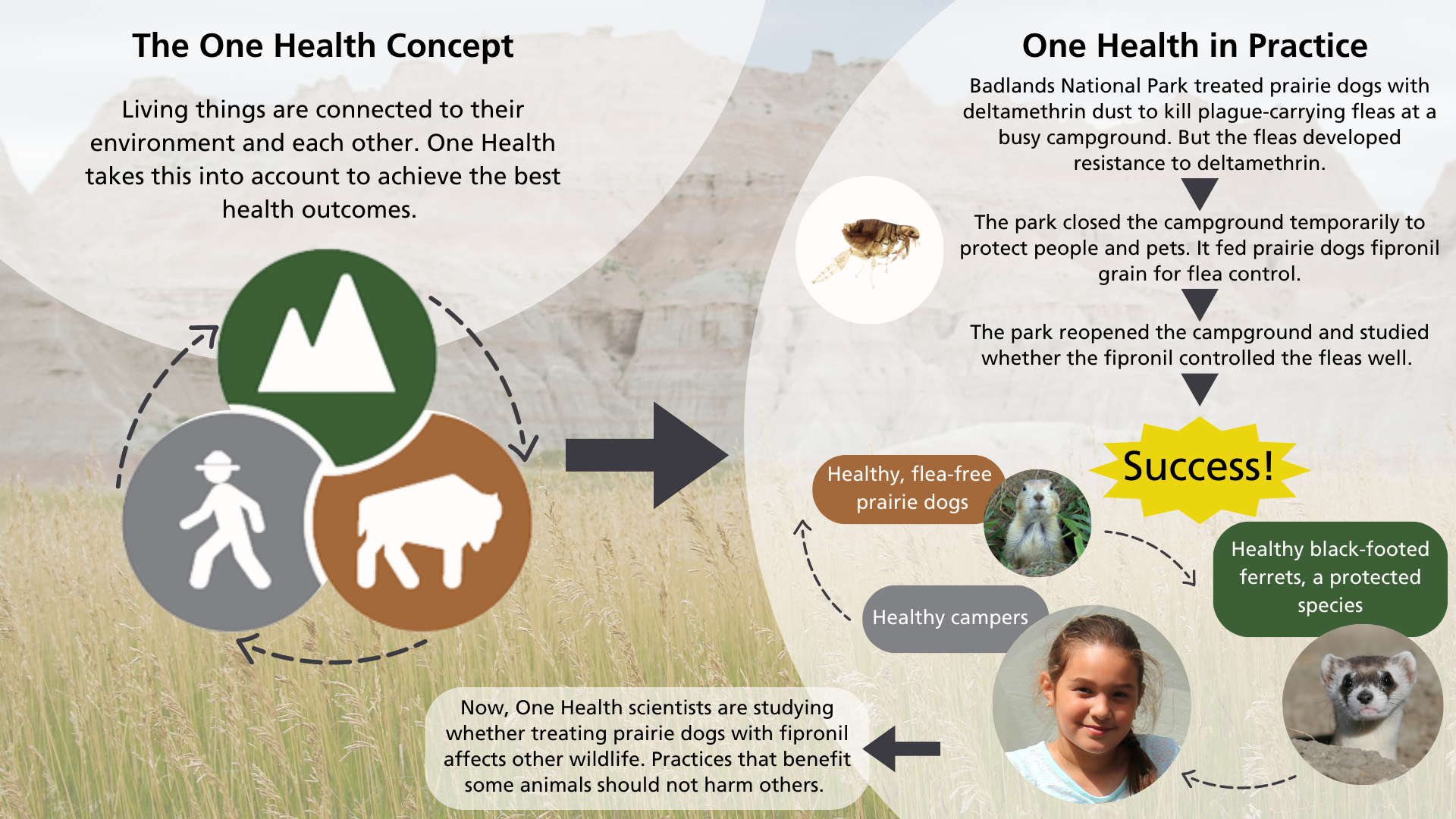
A 2022 paper published in the Journal of Vector Ecology showed that the campground treatment was highly effective in suppressing fleas. The treatment protected campers, some of whom had erected tents adjacent to prairie dog burrows. One Health scientists explained the treatment to campground visitors. Parents thought this had a positive impact on their children, and several children showed interest in becoming wildlife biologists. This work helped protect prairie dogs, a keystone species that is vital for ecosystem health, and thus helped to conserve the local population of endangered black-footed ferrets.
The interdisciplinary research to combat plague is a good example of One Health in practice. The current papers add to an accumulating number of studies demonstrating the usefulness of fipronil for flea control and plague mitigation. Researchers are also evaluating if fipronil has any unintended effects on non-target wildlife species. Practices that benefit one species hopefully will not harm other species of concern. The One Health perspective is critical and increasingly relevant in the face of climate change. Image credits: NPS
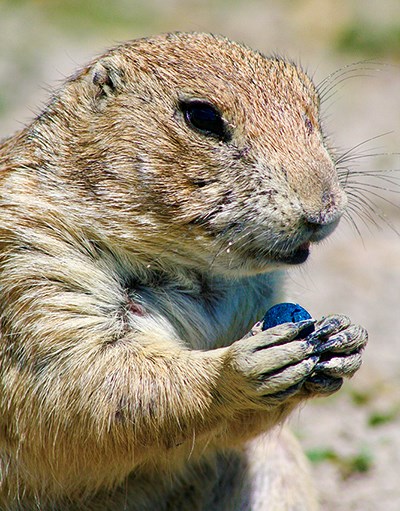
Image credit: U.S. Geological Survey / David Eads
A Bright Future
The future appears bright for plague mitigation in the western U.S. and abroad, with new methods under investigation. In 2021, for example, researchers evaluated pelletized baits, each containing small amounts of fipronil. The pellets proved effective in controlling prairie dog fleas and may reduce the costs of plague mitigation by 90 percent or more. Scientists are still developing this method.
In recent years, Badlands National Park has functioned as a hub for research on plague mitigation methods. “This part of South Dakota has been a wonderful laboratory for learning about plague ecology and methods to contain the disease,” said Biggins. “[It has] been especially useful in programmatically advancing black-footed ferret recovery nationwide.” Other national parks like Yosemite and Wind Cave are also participating in studies like these. As climate change causes old diseases to move and behave in new ways and new diseases to emerge, these tools and techniques may prove valuable for other ecosystems and species.
About the authors


